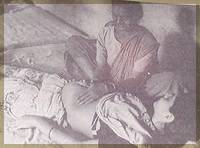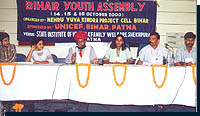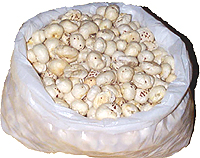News
Untrained midwives conduct 85% of deliveries
 In rural Bihar about 85 per cent of the deliveries are being conducted by untrained dais or family members.
In rural Bihar about 85 per cent of the deliveries are being conducted by untrained dais or family members.
This has been revealed by India Human Development Report, recently published by the National Council of Applied Economic Research, New Delhi. The survey was commissioned by the Planning Commission and supported by the consortium of international Organisations such as the United Nations Development Programme (UNDP), United Nations Children's Fund (UNICEF), United Nations Fund for Population Activities (UNFPA), and the Canadian International Development Agency (CIDA) at state level for different social groups.
The still births identified as baby born dead in rural Bihar comprised 15 per cent of births, which is reasonably very high in comparison to the all India level of 5.5 per cent. Such high rates of stillborn reflects the adverse outcome of pregnancy that is associated with low age of mother, poor nutritional level of the mother and non availability of primary health care in the state. Obviously the figure would be greater in rural Bihar.
|
Patna Youth Charter
 The three-day Bihar Youth Assembly concluded on 16
October with the release of the Patna Youth Charter. Over
a hundred youth leaders and activists from 37 districts of
Bihar participated in this extraodinary event. The Assembly
was inaugurated by the Union Minister of State for Human
Resource Development, Mr. Syed Shanawas Hussain,
himself a youth leader. He announced that every state
would be holding state youth assemblies.
The three-day Bihar Youth Assembly concluded on 16
October with the release of the Patna Youth Charter. Over
a hundred youth leaders and activists from 37 districts of
Bihar participated in this extraodinary event. The Assembly
was inaugurated by the Union Minister of State for Human
Resource Development, Mr. Syed Shanawas Hussain,
himself a youth leader. He announced that every state
would be holding state youth assemblies.
The youth identified and deliberated on 10 issues that
confronted the society of Bihar today. Persistence of child
labour was a major concern. The Charter urges the
Government and the people of Bihar to treat every working child
as "priority attention citizen". The Patna Charter also calls
for a society that is human rights centered, for
amendments to the legislation in light of the CRC and
CEDAW, for additional efforts to reach health goals and
implement education guarantee schemes. The charter
concludes "In order to achieve this, we declare ourselves as
the voice and champions of all women and children at risk in
Bihar and dedicate ourselves to the building of a new Bihar."
|
Over 54% children malnutrished in Bihar

Over 10 per cent children die of
preventable causes and atleast
54.05 per cent children remain
malnourished in Bihar. In fact, the
aforementioned figures have shot
up to 75 per cent in some districts
of the state.
This has been revealed in a recent workshop organised by
the UNICEF in Patna on the occasion of the release of a
report on the "State of World Children Report - 2001''. Chief
of the Child Development and Nutrition, UNICEF India,
Patrice Engle delivered a special lecture on "Early Childhood
development : The choice before us". She said that the
report on the state of children focussed on the need of
commitment to ensure healthy upstart of children's lives.
She said that Bihar is in dire need of investment towards
children's cause.
The report lamented that political leaders and economic
powers have failed to identify the essential factors for
human development. "The greatest tragedy is that most of
the decision-makers are simply unaware of the vulnerability
that the children face during the first three years of their
lives," the report said. UNICEF's State unit representative
Jean P Gough said that the only way to ensure proper
utility of a child's potential is to amply invest in favour of
children under three years of age.
|
Bihar Development Report
The Planning Commission has decided to get a development report prepared on residual Bihar. The Commission has assigned Institute for Human Development, a Delhi-based research organisation, to prepare this Bihar Development Report (BDR) latest by March 2001.
The Report will help in formulation of policy for the state. This will be an official report of
the Planning Commission and will be made public. More than 50 experts including bureaucrats who are well acquainted with the development issues are involved in this work. The report will not merely be a compilation of data on Bihar--it will try to identify appropriate strategies for the Centre. Some success stories of NGOs may be discussed in this report for larger replication. It will identify appropriate institutional structure and policy framework needed in the context of the suggested strategy. Recently, the Central Government has set up a special cell in the Planning department to study the economic situation in Bihar after division. The report may be utilised by this cell for recommending grants from Planning Commission.
|
Makhana on the verge of extinction
 The most important fruit grown in wetlands of Bihar, makhana (Euryle ferox) is now facing threat from environmental degradation.
The most important fruit grown in wetlands of Bihar, makhana (Euryle ferox) is now facing threat from environmental degradation.
India has about 4.1 million hectares (mha) of wetlands- 1.5 mha of natural land and 2.6 mha of land are being developed. Bihar accounts for its share, 273,395 ha, in the wetland regime of Indo-Gangetic flood plain. Bihar wetlands are the only place in India where Makhana is grown on a commercial basis. Madhubani and Darbhanga are the two major districts of north Bihar where Makhana cultivation is undertaken on a large-scale. It provides a means of sustenance to thousands of people in Bihar. But now Makhana cultivation is facing a threat from environmental degradations. Wetlands are turning into wasteland. Desiltation is slowly converting the wetlands into wastelands. The livelihood of a large number of families is also at stake who are dependent on farming of Makhana.
Bihar accounts for 75 per cent of country's total Makhana output. The expenditure incurred over Makhana cultivation is very modest. Once a man starts its cultivation, the established ecosystem works for years. Seeds left over from the previous year's harvest germinate as the crop for the next season. Only labour is required for thinning out the overgrowths and collecting dispersed seeds from the pond bed during harvest. The leaves from the previous year's crop act as a natural fertiliser. There is no need of fertilizer.
The fruit has a great nutritional value - 9.7 per cent protein, 76.9 per cent carbohydrate, 0.1 per cent fat, 1.3 per cent minerals and 12 per cent water. It has been traditionally used to treat certain diseases such as beri beri. It is also used in the preparation of certain medicines and starch coating of Banarsi sarees.
Proper management and scientific farming with commercial interest can help large number of families living below poverty line to lead a better life. Policy-makers and planners should understand this valuable ecosystem. But no measures are being taken by the State Govt. for the proper management of wetlands.

More...
Back
| |



